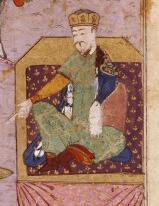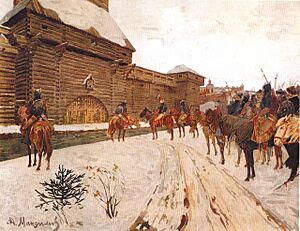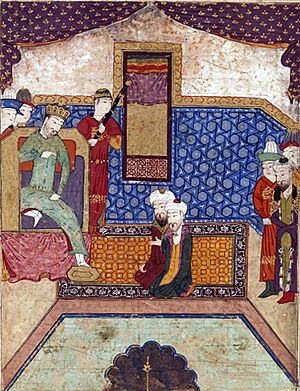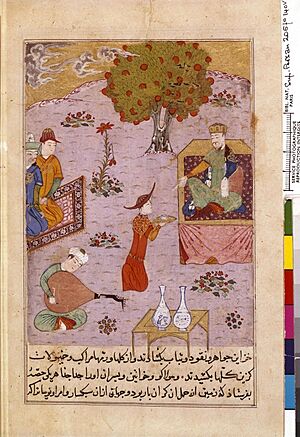Güyük Khan facts for kids
Quick facts for kids Güyük Khan |
|||||||||||||
|---|---|---|---|---|---|---|---|---|---|---|---|---|---|

A fifteenth-century depiction of Güyük
|
|||||||||||||
| Khagan of the Mongol Empire | |||||||||||||
| Reign | 24 August 1246 – 20 April 1248 | ||||||||||||
| Coronation | 24 August 1246 | ||||||||||||
| Predecessor |
|
||||||||||||
| Successor |
|
||||||||||||
| Born | 19 March 1206 Khamag Mongol |
||||||||||||
| Died | 20 April 1248 (aged 42) Mongol Empire |
||||||||||||
| Burial | Unknown, presumptively Burkhan Khaldun | ||||||||||||
| Spouse | Oghul Qaimish | ||||||||||||
|
|||||||||||||
| House | Borjigin | ||||||||||||
| Father | Ögedei Khan | ||||||||||||
| Mother | Töregene | ||||||||||||
| Religion | Tengrism | ||||||||||||
Güyük Khan (born around 19 March 1206 – died 20 April 1248) was an important leader of the Mongol Empire. He was the third Khagan, which means "Great Khan" or supreme ruler, of the vast Mongol lands. Güyük was the oldest son of Ögedei Khan and a grandson of the famous Genghis Khan. He ruled for a short time, from 1246 to 1248.
Güyük started his military career by helping conquer the Eastern Xia kingdom. Later, he took part in the Mongol invasion of Europe. After his father passed away, Güyük was chosen to be the Great Khan in 1246. During his rule, which lasted almost two years, he changed some unpopular rules made by his mother. He also ordered a count of all the people in the empire. He even had power in Eastern Europe, choosing new leaders for important areas like Vladimir and Kiev.
Contents
Güyük Khan's Appearance and Personality
According to a traveler named Giovanni da Pian del Carpine, Güyük was of average height. He was described as very careful and smart. People saw him as serious and calm in his actions.
Early Life and Military Service
Güyük received military training from a young age. He served as an officer under his grandfather, Genghis Khan, and later under his father, Ögedei Khan. He married a woman named Oghul Qaimish from the Merkit clan.
In 1233, Güyük helped conquer the short-lived Dongxia Kingdom. This kingdom was led by Puxian Wannu, who had rebelled against the Jin Dynasty. The Mongols conquered it in just a few months.
After his uncle Tolui died, Güyük's father, Ögedei, suggested that Tolui's widow, Sorghaghtani, marry Güyük. However, Sorghaghtani politely refused. She said her main duty was to raise her own sons.

Güyük also joined other Mongol princes in the invasion of Eastern and Central Europe between 1236 and 1241. During this time, he led his own group of soldiers in important battles, like the Siege of Ryazan. He also took part in the long siege of Maghas, the capital of Alania.
During the European campaign, Güyük had a big argument with his cousin, Batu Khan. Because of this fight, Güyük and another prince were called back to Mongolia. His father, Ögedei, was very upset. Ögedei told Güyük that winning wars wasn't just about fighting, but also about treating his own soldiers well and working together. After this, Güyük was sent back to Europe.
Meanwhile, Ögedei Khan passed away in 1241. His wife, Töregene Khatun, became the regent, meaning she ruled until a new Great Khan was chosen. She used her power to support her son, Güyük. Even though Batu Khan tried to delay the process, Töregene succeeded in getting Güyük elected as Khan in 1246. When Genghis Khan's youngest brother, Temüge, tried to take the throne from Töregene, Güyük quickly returned to Mongolia to secure his position.
Becoming the Great Khan (1246)
Güyük's official crowning ceremony happened on August 24, 1246. It took place near the Mongol capital, Karakorum. Many important people from other countries attended this event. These included a friar and envoy from Pope Innocent IV, leaders from Georgia, the brother of the king of Armenia, and ambassadors from the Abbasid Caliph and the Delhi Sultanate.
According to John of Plano Carpini, Güyük was formally elected at a large meeting of tribes called a kurultai. This meeting took place at a camp called Sira Orda, or "Yellow Pavilion." About 3,000 to 4,000 visitors from all over Asia and Eastern Europe came to offer their respect and gifts. After this, they witnessed the official crowning at another camp called the "Golden Ordu."
The 13th-century historian Ata-Malik Juvayni described the huge gathering:
- Leaders and officials came from China.
- Important people arrived from Central Asia.
- From Persia and other regions, many famous figures attended.
- Sultans and rulers from places like Rum (modern-day Turkey) and Georgia were present.
- Envoys also came from Aleppo, Mosul, and Baghdad.
- There were also representatives from European countries and other distant lands.
- So many envoys and messengers arrived that two thousand felt tents were set up for them.
- Merchants also came with rare and valuable goods from both the East and the West.
When the Pope's envoy, John of Plano Carpini, complained about Mongol attacks on European kingdoms, Güyük explained that these kingdoms had harmed Mongol envoys in the past. He also declared that "all the lands have been made subject to the Great Khan," showing his belief in Mongol world rule. Güyük wrote a letter to Pope Innocent IV, telling him that if he wanted peace, he and other kings must come to the Mongols to show their submission.
Around this time, Güyük's relationship with his mother, Töregene Khatun, became very difficult. Güyük had his mother's favorite advisor arrested and executed for corruption. He also removed many officials appointed by his mother. Töregene herself died later, possibly on Güyük's orders. Güyük also had his uncle Temüge investigated and executed. He replaced the young ruler of the Chagatai Khanate with his favorite cousin to strengthen his power. Güyük also brought back many of his father's trusted officials to important positions.
Güyük Khan's Rule (1246–1248)
Güyük changed several unpopular rules made by his mother. He proved to be a surprisingly capable leader. He sent a general named Eljigidei to Persia to prepare for attacks on Baghdad and the Ismailis. He also continued the war against the Song Dynasty in China. However, he was also somewhat insecure and upset some people by punishing officials from the previous government.
The Seljuk princes in Rum (Turkey) were constantly fighting for the throne. Güyük ordered one of them, Kilij Arslan IV, to be made sultan. A Mongol official with 2,000 Mongol soldiers was sent to make sure this happened. When two Georgian kings, David Narin and David Ulu, came before Güyük, he made David Ulu the senior king and divided the Kingdom of Georgia between them.
After a treaty between the Mongols and Cilician Armenia in 1243, the Armenian king sent his brother to Güyük's court. In 1247, they made a formal agreement. Cilician Armenia became a vassal state of the Mongol Empire, meaning it was under Mongol protection and paid tribute. Because Armenia surrendered willingly, its king's brother received a Mongol wife, and the kingdom was spared from Mongol overseers and heavy taxes. Güyük also demanded full submission from the Abbasid Caliphate and the Ismailis.
Güyük ordered a census across the entire empire. In 1246, he issued a decree that taxes, ranging from 1/30 to 1/10 of the value, would be collected on everything. A heavy head tax was also collected from men in Georgia and Armenia. Güyük was a strict and intelligent person.
Güyük sent a general named Amuqan to Korea. In July 1247, the Mongols camped near Yiom-ju. The Korean king refused to move his capital. So, Amuqan's forces raided the Korean Peninsula until 1250.
Even though Batu Khan did not support Güyük's election, he respected the Great Khan. After their father's death, Batu sent Andrey and Alexander Nevsky to Karakorum in 1247. Güyük appointed Andrey as the Grand Prince of Vladimir and gave Alexander the princely title of Kiev. In 1248, Güyük asked Batu Khan to come meet him in Mongolia. Some people thought this was a trick to arrest Batu. Batu started moving towards Mongolia with a large army. When Güyük also began moving westward, Sorghaghtani warned Batu that he might be Güyük's target.
Güyük died on his journey, in what is now Qinghe County, Xinjiang, China. Some historians believe he might have been poisoned. However, others think he died from natural causes because his health was not good. After his death, his widow, Oghul Qaimish, became the regent. But she was unable to keep the leadership within her family branch. Möngke became the next Great Khan in 1251.
Family Life
It was common for powerful Mongol men to have many wives and partners. We don't know exactly how many wives or partners Güyük had.
- His main wife was Wuwuerheimishi, from the Merkit tribe.
- Another wife was Empress Naimanzhen.
- Empress Qinshu (died 1251), also from the Merkit tribe, was another important wife.
- She had two sons: Khoja and Naqu.
- He also had other children from unknown wives or partners:
- A third son named Khokhoo.
- Two daughters: Babahaer and Yelimishi.
Güyük Khan's Legacy
Güyük's death had a big impact on world history. He had planned to focus Mongol power on Europe. However, his early death prevented the Mongol forces from moving further west into Europe. After Güyük's death, family politics within the Mongol Empire caused their efforts to shift towards southern China. This region was eventually conquered during the rule of Kublai Khan.
When Kublai Khan established the Yuan Dynasty in 1271, he officially recognized Güyük Khan with the temple name Dingzong.




